[ad_1]
What Is a Buddha Bowl?
Buddha Bowl recipes help you repurpose leftovers and use every last bit of produce in your fridge with a simple formula that builds a well-rounded, delicious, and nutritious meal. These colorful and versatile one-bowl meals are not only a great way to reinvent boring leftovers, but they also help to reduce food waste and save you money in the process. What’s more—they incorporate a myriad of whole foods and are fairly simple to whip up, also saving you time and effort.
Let’s take a deep dive into the philosophy behind these beautiful meals and talk about how you can create your own deliciously healthy Buddha Bowl.
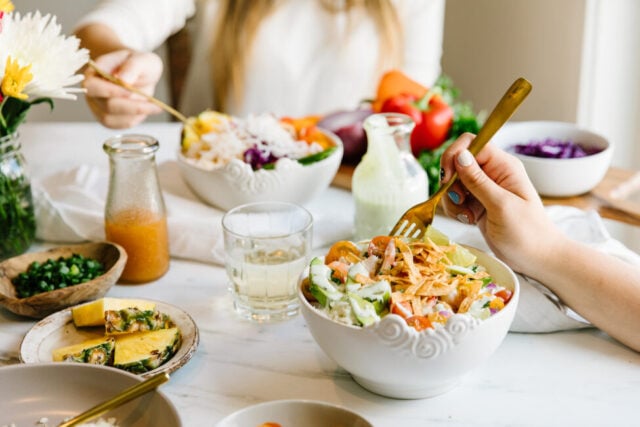
The Origin of Buddha Bowls
Despite the often-used imagery of those chubby Buddha statues, the Buddha was quite thin. In fact, Buddhist monks have been eating a specific way for thousands of years, with more regard to when they eat, rather than what they eat. The Buddha himself at only at specific times during the day, a practice very similar to what we know of as intermittent fasting. He would also walk the villages with a bowl, which locals would fill with whatever food they could spare. Whatever was placed in his bowl was what he ate. Thus began the practice of eating a one-bowl meal that contained a variety of colorful ingredients.
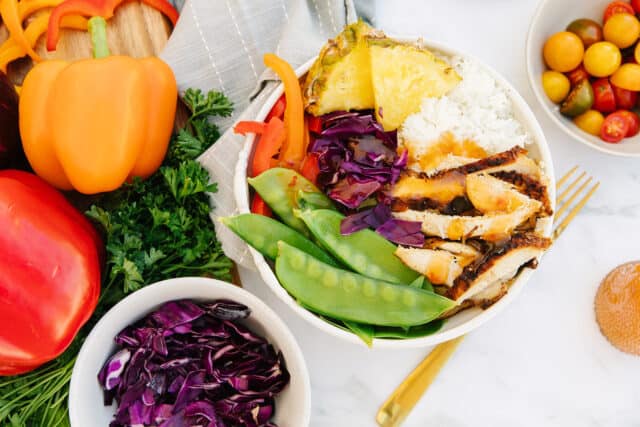
Nourish, Power, Hippie, Buddha—What’s the Difference?
There are so many types of bowls these days, it’s hard to keep up sometimes! Here’s a rundown of each bowl, and how they contrast with what we know today as the modern Buddha Bowl.
Nourish Bowls focus on being nutrient dense. That’s why they’re generally packed with a variety of healthy ingredients that provide the body a ton of vitamins, minerals, and macronutrients. They often consist of fresh vegetables, whole grains, lean proteins, and healthy fats. The goal of Nourish Bowls is to fill you up while simultaneously fueling your body with essential nutrients.
Power Bowls are designed specifically to boost energy and support an active lifestyle. Many contain high-protein ingredients to help build muscle and shorten workout recovery time, which makes them very popular among athletes and fitness enthusiasts. When you think of Power Bowls, your first thought might be those Acai Bowl shops that have seemed to pop up everywhere, and yes, those are considered a form of Power Bowl. However, these shops tend to offer much more indulgent and generally calorically-heavy (and wildly expensive!) Power Bowls filled with high-sugar fruits and toppings like chocolate chips and almond butter.
Hippie Bowls are usually plant-based and focus mainly on whole, unprocessed ingredients rather than animal proteins. They often include a variety of colorful vegetables, and proteins in the form of legumes, nuts, and seeds. The general idea of Hippie Bowls is to create a healthy meal that’s also environmentally sustainable, one that follows a more natural, holistic lifestyle.
Grain Bowls are very similar to Buddha Bowls (and are often just another name for Buddha Bowls), but they focus on whole grains such as quinoa, brown rice, or farro instead of all grains. Like Buddha Bowls, a Grain Bowl would also include a mix of veggies and protein, and are usually topped with a yummy dressing or sauce. These bowls are highly versatile and customizable to fit an array of dietary preferences and tastes.
Macro Bowls (short for macrobiotic) are all about following the macrobiotic diet, which includes a balance of whole grains, vegetables, beans, and fermented foods that are believed to promote health and longevity. The macrobiotic diet also focuses on eating seasonal and local foods, and like the Hippie Bowl, avoiding processed foods.
You can see how a lot of these bowls contain similar ingredients, and that the biggest difference between them is their intent. That’s what we love so much about Buddha Bowls. They integrate many elements of these bowls into one to create a comprehensive and well-rounded meal.
Buddha Bowls are kind of a hybrid of Nourish Bowls, Grain Bowls, and Hippie Bowls. They feature a variety of raw and cooked veggies, grains, a lean protein, and are topped off with a yummy dressing and a crunchy addition for texture. Buddha Bowls are probably known best for their colorful and vibrant appearance. They can be vegan or vegetarian by focusing on plant-based proteins, pescatarian, or basic for regular ol’ omnivores.
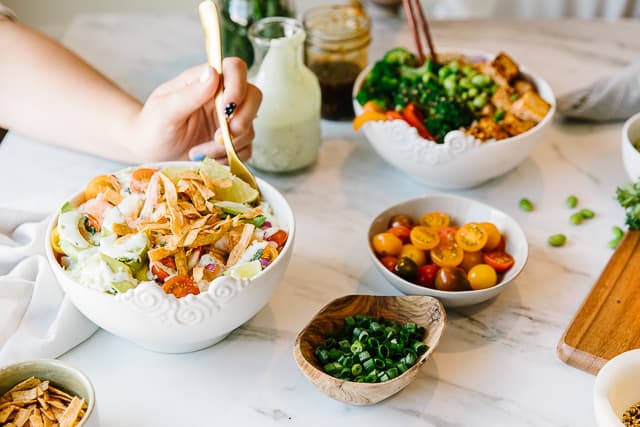
How to Build Your Own Buddha Bowl
Creating your own Buddha Bowl is fun and easy, and the combinations are endless. Here’s the formula for crafting the perfect bowl:
- Pick Your Base: Start with a base of leafy greens or grains like rice, quinoa, or noodles.
- Add Colorful Veggies: Use fresh veggies or grab some scraps from your crisper drawer. They can be raw or cooked, depending on your preference. Some good options are bell peppers, cherry tomatoes, purple cabbage, and brussels sprouts.
- Add a Lean Protein: Choose a plant-based protein like black beans or tofu, or opt for an animal protein like grilled chicken, shrimp, or shredded pork.
- Add a Flavorful Sauce: The sauce is what ties it all together. You can choose a store-bought sauce or dressing, but homemade pesto, peanut sauce or tahini sauce are all super easy to whip up! If that’s too much, you can always opt for a super simple dressing of soy sauce and sesame oil.
- Finish it Off with a Crunchy Topping: Top your bowl with seeds, nuts, or crispy onions for a little bit of texture and crunch!
Are Buddha Bowls Healthy?
The healthiness of a Buddha Bowl truly depends on what you choose to throw in it. If health is the goal, then we recommend focusing on nutrient-dense foods like fresh vegetables, whole grains, and lean proteins. This combo of ingredients is inspired by East Asian diets, which are known for lowering inflammation. Likewise, ensuring your sauce isn’t chock full of sugar or preservatives is always a good call.
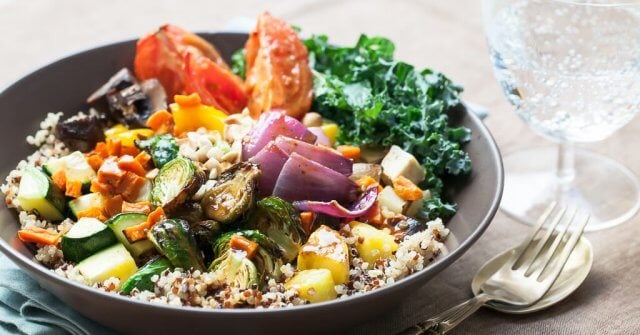
Tips for Making the Perfect Buddha Bowl
- Balance Out Your Flavors and Textures: The best Buddha Bowls have a mix of flavors (the 5 S’s: sweet, salty, savory, sour or tangy, and spicy) and textures (crunchy, creamy, chewy). The more you can vary these flavors and textures, the better your bowl will be. Here’s a tip: Try adding sweet potatoes for a touch of sweetness or red onions for a bit of zing.
- Experiment with Dressings: A lot of the ingredients used in Buddha Bowls absorb flavor well, like tofu, certain veggies, and even plain chicken. So your dressing (and seasonings, if you so choose) can change the entire vibe of the bowl! Some options you might choose from include balsamic vinegar, lemon juice, or a simple olive oil and soy sauce mix.
- Incorporate Seasonal Produce: Using in-season veggies is not only cheaper, but more flavorful, and it allows you to support local farmers.
- Use Leftovers Creatively: Buddha Bowls are perfect opportunity to use up leftovers, and not just proteins or about-to-turn veggies, but rice and noodles as well! Use what you got and throw them right in your bowl.
Buddha Bowls Around the World
Buddha Bowls are so versatile you can even customize them based on culture. Here are a few ways to achieve that:
- Mexican Buddha Bowl: Use a base of brown or Spanish rice. Throw in some black beans, bell peppers, and corn. Top with avocado, lime juice, and a sprinkle of chili powder for a southwestern twist. Want to take it to the next level? Make your bowl a taco shell bowl!
- Mediterranean Bowl: Start with a base of quinoa or couscous. Add in some cucumbers, cherry tomatoes, red onions, and feta cheese. Finish it off with a drizzle of olive oil and lemon juice.
- Asian-Inspired Bowl: Use white rice or rice noodles as your base. Add in some raw veggies like carrots, purple cabbage, and edamame, and shrimp as a lean protein. Top with a drizzle of sesame oil and soy sauce.
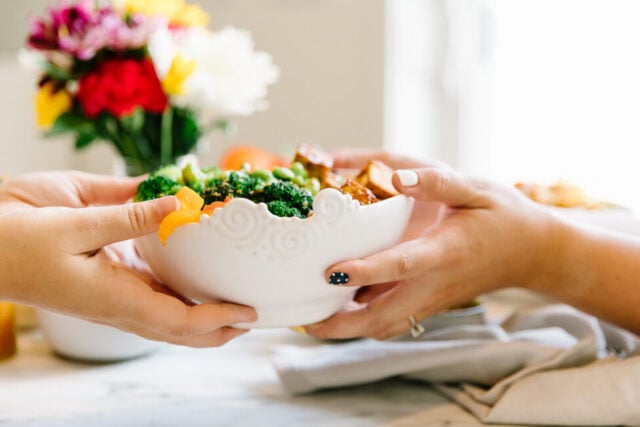
What Will You Put in Your Buddha Bowl?
Buddha Bowls are meant to be fun, healthy, and creative path to lots of flavor, so be sure to experiment with your own!
What do you like to throw in your Buddha Bowls? We’d love to hear all about it! Be sure to leave us a comment with your favorite Buddha Bowl ingredients!
Visa $100 Gift Card Giveaway
Got your own Buddha Bowl ideas? Enter this week’s Visa $100 Gift Card Giveaway to purchase everything you need to make them!
[ad_2]
Source link